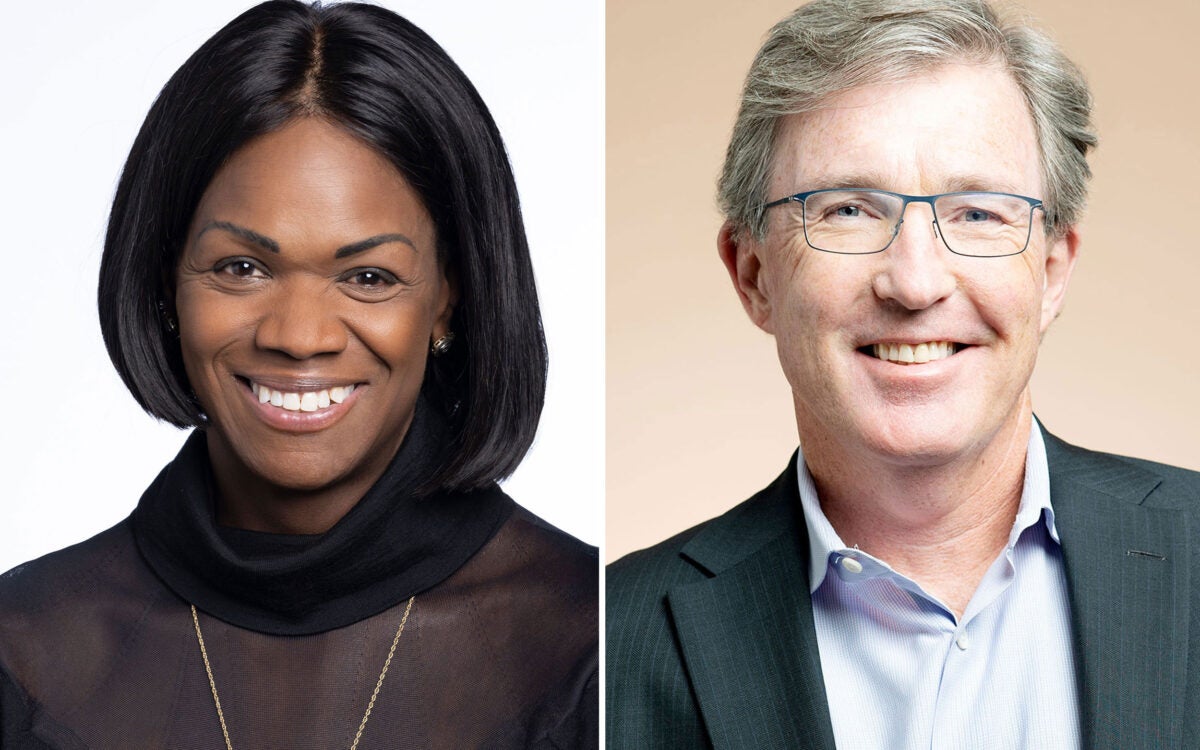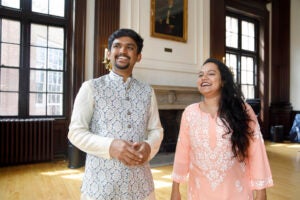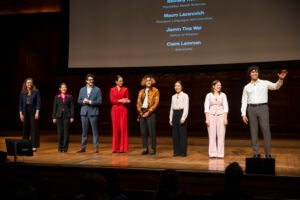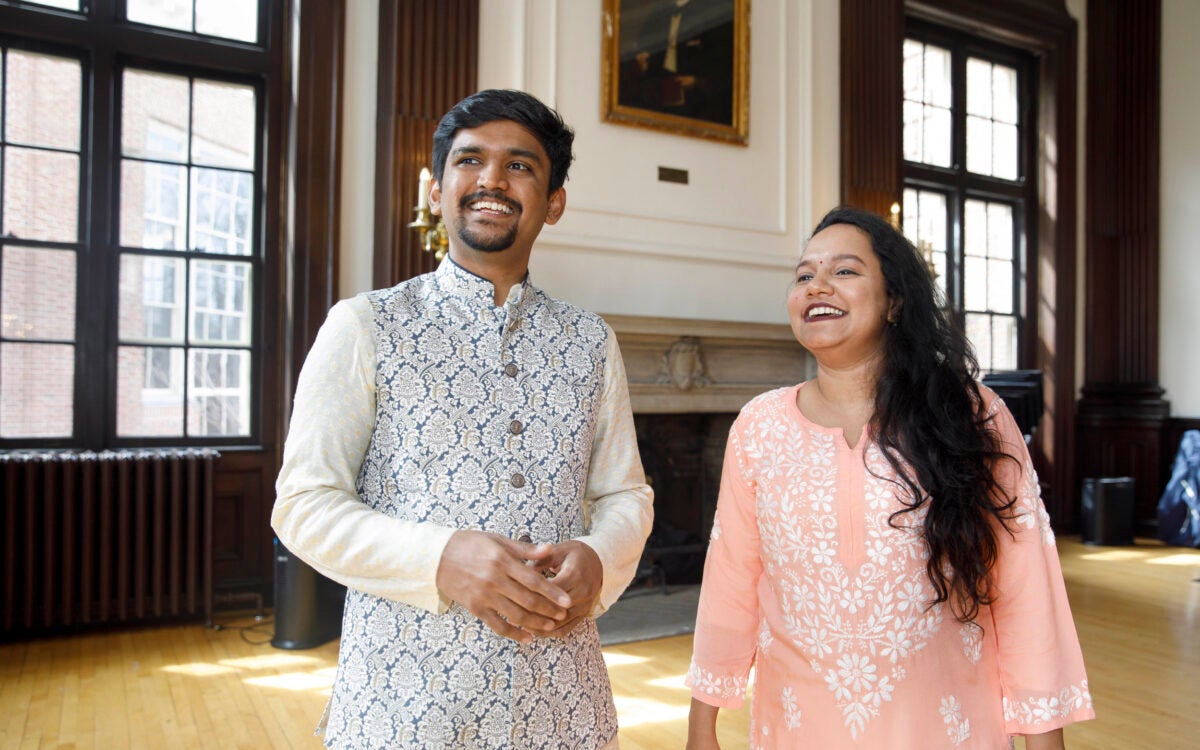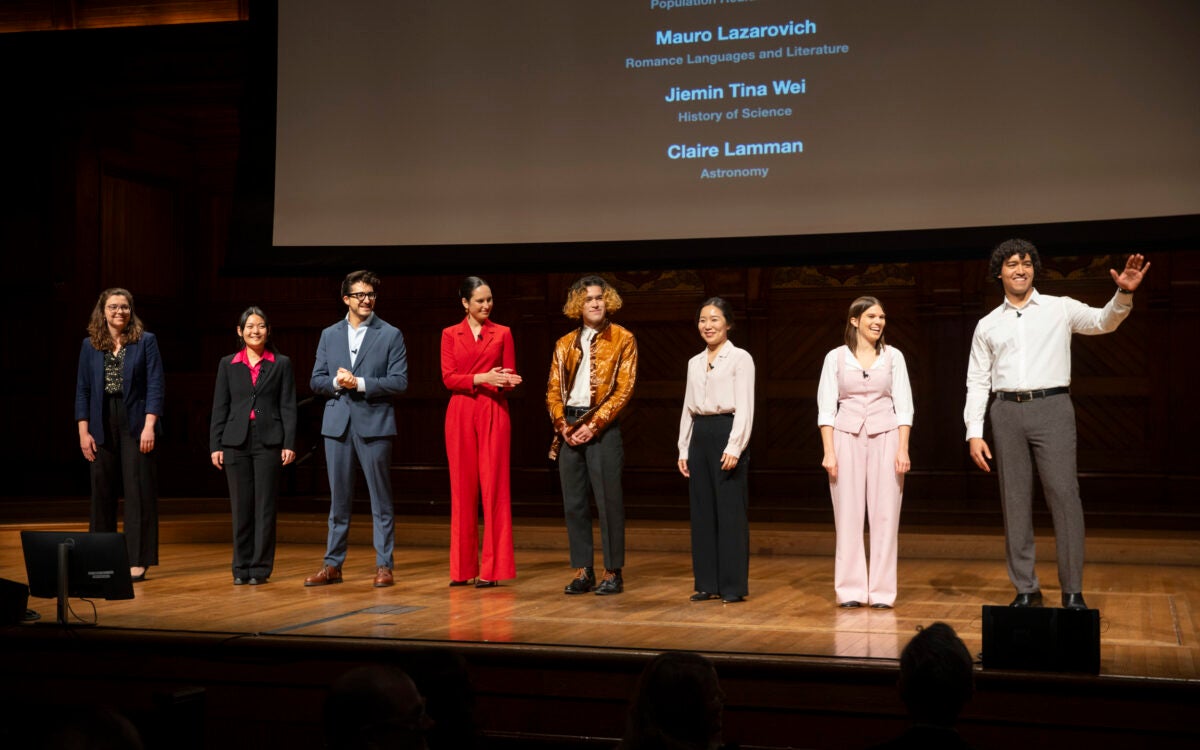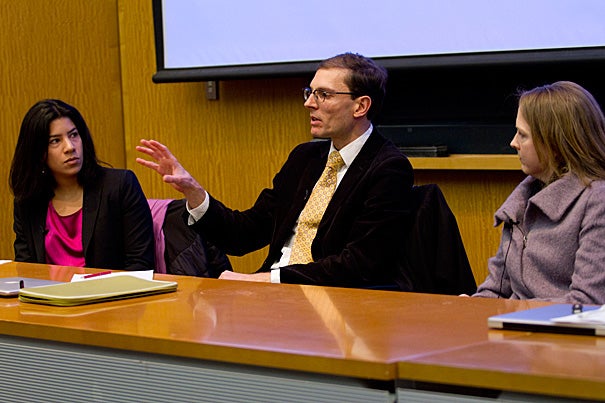
Maya Jasanoff and her faculty colleagues gathered at the Tsai Auditorium on Feb. 16 and March 7 to consider how the Faculty of Arts and Sciences (FAS) may look in a generation. The February session included, among others, Jasanoff (from left), Harvard faculty Martin Puchner, and Ann Pearson.
Amanda Swinhart/Harvard Staff Photographer
A peek at Harvard’s future
Conversations @ FAS explores impact of digital revolution
When Maya Jasanoff arrived on campus as a freshman two decades ago, the Harvard that she came to know was vastly different from that of today.
“At that time, we pored over facebooks in our dorm rooms in hard copies,” said Jasanoff, now a professor of history at the University. “We made social plans by calling our friends on phones that plugged into the wall. There were no iPhones, no iPads, no iPods, and no iSites. There was no Google, no YouTube, and no Wikipedia.”
Technology has dramatically changed teaching, learning, and research at Harvard since Jasanoff set foot on campus 20 years ago. The digital revolution promises even greater changes in the decades ahead. With this in mind, Jasanoff and her faculty colleagues gathered at the Tsai Auditorium on Feb. 16 and March 7 to consider how the Faculty of Arts and Sciences (FAS) might look in a generation. The discussions were part of the Conversations @ FAS series, which this year asks some of Harvard’s leading scholars to imagine the faculty at 400.
“As a signature event for Harvard’s 375th anniversary year, this is an opportunity for us to look forward and think about where we want to go in the future,” Faculty of Arts and Sciences Dean Michael D. Smith said, in welcoming attendees. “We are here to explore big topics both in the areas of research as well as teaching and learning.”
“For many of us, change spells a magnificent opportunity, but it also makes us take stock of our values and goals,” Jasanoff added. “This year’s Conversations @ FAS have a simple goal: to reflect together on what freshmen entering Harvard in 2036 — the year of the University’s 400th anniversary — might see and gain from their experience here.”
On Feb. 16, some of Harvard’s leading scientists considered the challenges and opportunities offered by advances in technology and expanded access to information. The panel, moderated by Jasanoff, included Professor of Astronomy David Charbonneau, Alexander Agassiz Professor of Zoology Hopi Hoekstra, and Professor of Biogeochemistry Ann Pearson. Martin Puchner, the Byron and Anita Wien Professor of Drama and of English and Comparative Literature, added perspective from the humanities.
Charbonneau said that one of the largest changes in the sciences in recent decades is the explosion of the amount of data researchers must sift through to find meaningful results. He cited the example of Zachary Berta, then a fourth-year graduate student, who discovered the first planet outside our solar system in 2009. While Berta had received extensive training as an astrophysicist, it was his data-gathering skills that enabled the discovery, Charbonneau said.
“What Zach did that other people couldn’t do was to develop advanced data-management and data-visualization skills,” he said. “I think this is not uncommon in the sciences, because we teach students one way, and we certainly want them to have the skills we believe are important as scholars, but how they distinguish themselves and advance through academia is due to some other set of skills.”
Just as the pace of technological change has led to an explosion in data emerging from labs, so too has it dramatically altered the landscape of the equipment used to generate that data, said biogeochemist Pearson. And while technology drives down the price of some devices, it sends others to previously unseen heights. In the case of DNA sequencers, Pearson said, technology is evolving so rapidly that instruments purchased only a few years ago are already obsolete, and the cost of the newest models continue to rise.
“The expectation is that every lab would have access to something like this to keep up with the times,” she said. “In many ways, this is a very pressing responsibility on individual investigators and on us as a university, to keep up with the technology, because we need to ensure our investigators have access to the pace of change.”
On March 7, a second panel of scholars discussed the aspects of Harvard’s past and present that the University might carry into the future. Jasanoff again moderated the discussion, which included Professor of Government and African and African American Studies Claudine Gay, Professor of Psychology Matthew Nock, and Professor of Religion and Indian Philosophy Parimal Patil. Associate Professor of Electrical Engineering Robert Wood offered a hard science take on the topic.
Gay made the case for the continuing importance of a brick-and-mortar campus in a digital age. She acknowledged that technology is transforming the way that students learn and that scholars engage and collaborate, and said that Harvard should be part of that revolution. But Gay said that technology also encourages students and scholars to “microtarget” and self-select into narrower worlds. Physical campuses are crucial for the “serendipity that drives research and teaching.
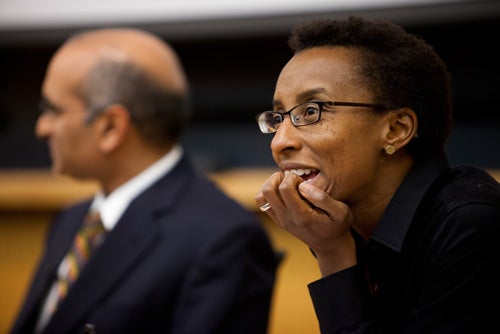
“What is the substitute for the random five-minute conversation that takes place after a lecture?” Gay asked, “or the encounter in Harvard Yard where you find out that a colleague has already collected the data you’ve been searching for? It’s in these kinds of informal moments that a lot of [discovery] happens, not in the structured spaces of a classroom. Yet those structured spaces are exactly what the virtual world seeks to emulate.”
Nock argued that it was critical to bring the process of peer review and evaluation of scholarly work into the future. He said that the information age might accelerate the advances in scientific research through greater transparency and rapid review. At the same time, digital technology poses new challenges to the system.
“There’s an overwhelming increase of information in a world where publication is increasingly easy,” he said. “So there’s a need for better filtering to separate nonscience from science. There are also a skyrocketing number of scholarly journals and articles. How do we make decisions about what gets published?”
The presentations concluded with a discussion of the liberal arts and their enduring value, delivered by Patil. Patil argued for “slow academics,” an approach to learning that teaches students the painstaking process of knowledge creation, from data gathering through analysis and conclusion. He said that, in the future, the FAS would need to build spaces for “slow, detail-oriented learning” into an increasingly fast-paced, goal-driven campus, and to encourage students and scholars to talk to people with whom they are likely to disagree.
Patil closed his presentation with an ancient Sanskrit saying that spoke to the different aspects of the learning process, and that underscored the need for Harvard to preserve them in the future.
“A student gets one quarter of their knowledge from the teacher;” he said, “a quarter from their own intelligence; a quarter from their peers; and a quarter from time.”
For more on Conversations @ FAS – including video of the 2012 discussions – visit the series’ website.
